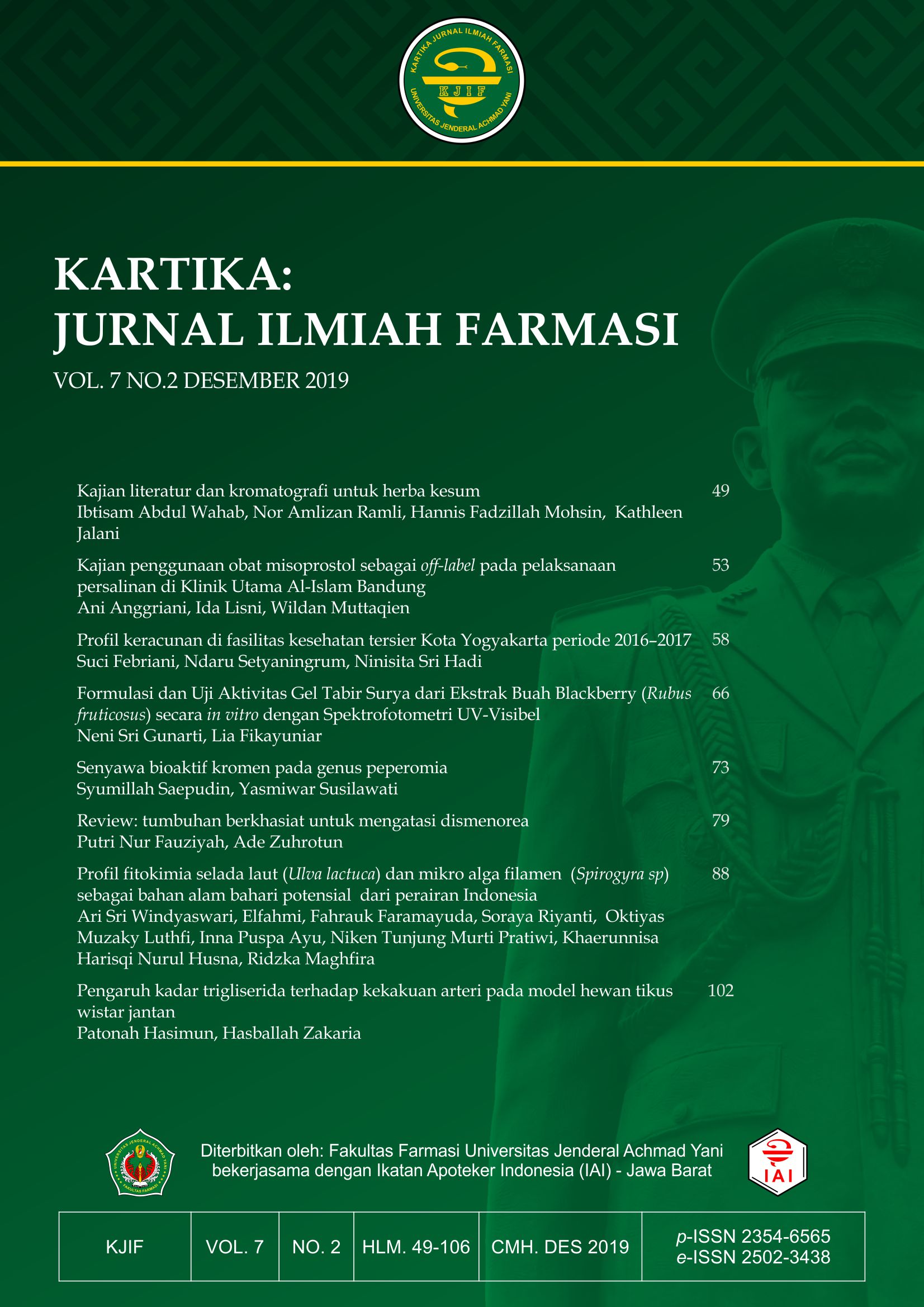Profil fitokimia selada laut (Ulva lactuca) dan mikro alga filamen (Spirogyra sp) sebagai bahan alam bahari potensial dari perairan Indonesia
DOI:
https://doi.org/10.26874/kjif.v7i2.288Abstrak
Abstrak
Perairan Indonesia merupakan habitat bagi berbagai spesies makro dan mikro alga. Selada laut (Ulva lactuca) adalah salah satu makroalga hijau yang secara empiris digunakan sebagai makanan oleh masyarakat Indonesia yang hidup dipesisir pantai. Pada perairan tawar, ganggang hijau (Spirogyra porticalis) merupakan mikroalga filamen yang berperan penting sebagai bioindikator dalam sistem akuatik. Penelitian ini bertujuan untuk mengetahui profil fitokimia dari selada laut dan ganggang hijau yang tumbuh di perairan Indonesia. Hasil pengujian kualitatif pada selada laut (Ulva lactuca)  menunjukkan kandungan metabolit primer  dan sekunder berturut-turut adalah karbohidrat, alkaloid, flavonoid, mono dan seskuiterpenoid. Sementara itu ganggang hijau (Spirogyra porticalis) mengandung karbohidrat, protein, alkaloid, flavonoid, fenolik, tannin, kuinon, mono dan seskuiterpenoid. Pola kromatogram selada laut (Ulva lactuca) dan ganggang hijau (Spirogyra porticalis) mendeteksi aktivitas antioksidan yang dimiliki oleh senyawa- metabolit sekunder seperti fenol, tannin, flavonoid, mono dan seskuiterpenoid yang memiliki variasi kepolaran dari semi hingga polar. Hasil uji pendahuluan aktivitas antioksidan menggunakan metode dinamolisis menunjukkan selada laut (Ulva lactuca) dan  ganggang hijau (Spirogyra porticalis) memiliki aktivitas antioksidan dan berpotensi dikembangkan sebagai obat, suplemen, eksipien farmasi dan makanan nutrisi.
Â
Kata kunci: selada laut (Ulva lactuca), ganggang hijau (Spyrogyra porticalis), antioksidan, bahari, Indonesia.
Â
Abstract
Indonesian waters are habitat for various macro and micro algae species. Sea lettuce Ulva lactuca is one of the green macroalgae that is empirically used as food by Indonesian people. In freshwater, green algae Spirogyra porticalis is filament microalgae that play an important role as bioindicators in the aquatic system. The aim of this research was to profiling the chemical constituent from native Indonesian sources, Ulva lactuca  and Spirogyra porticalis. The results of  Ulva lactuca  qualitative analysis showed the content of primary and secondary metabolites are carbohydrates, alkaloids, flavonoids, mono, and sesquiterpenoids, respectively. On the other hand, green algae Spirogyra porticalis carbohydrates, proteins, alkaloids, flavonoids, phenolics, tannins, quinones, mono, and sesquiterpenoids, respectively. The chromatogram pattern of sea lettuce Ulva lactuca and  Spirogyra porticalis showed the antioxidant activity caused by secondary metabolites such as phenol, tannin, flavonoids, mono and sesquiterpenoids which were various polarity. Preliminary test results of antioxidant activity with the dinamolysis method showed sea lettuce Ulva lactuca  and and green algae Spirogyra porticalis have antioxidant activity. It potentially developed as drugs, supplements, pharmaceutical excipients and nutritional foods.
Â
Keywords: sea lettuce Ulva lactuca, green microalgae Spyrogyra porticalis, antioxidant, marine, Indonesia,
Referensi
Ahmed. S. Dwaish, D. Y. M. Y. and S. N. L. (2016). Use of (Spirogyra porticalis) sp. Extract Against Multidrug Resistant Bacterial pathogens. International Journal of Advanced Research, 4(4), 144–149. https://doi.org/10.21474/IJAR01
Banaee, M., Taheri, S., & Hedayatzadeh. (2018). Effects of Cadmium and Dimethoate on Some Biological and Biochemical Indices in Freshwater Green Algae, (Spirogyra porticalis) sp. 4(4), 593–603. https://doi.org/10.22059/poll.2018.251851.389
Champa, P., & et al. (2016). Determination of phytochemical compound from (Spirogyra porticalis) sp. using ultrasonic assisted extraction. International Journal of GEOMATE, 11(2), 2391–2396. https://doi.org/10.21660/2016.24.1277
Claudia Barraza-Elenes, Irma L. Camacho-Hernández, Elhadi M. Yahia, José J. Zazueta-Morales, Ernesto Aguilar-Palazuelos, J. Basilio Heredia, Dolores Muy-Rangel,
Carlos I. Delgado-Nieblas, Armando Carrillo-López. Analysis by UPLC–DAD–ESI-MS of Phenolic Compounds and HPLC–DAD-Based Determination of Carotenoids in Noni (Morinda citrifolia L.) Bagasse. Journal of Agricultural and Food Chemistry 2019, 67 (26) , 7365-7377. https://doi.org/10.1021/acs.jafc.9b02716
Chowdhury, M. M. H., Kubra, K., Hossain, M. B., Mustafa, M. G., Jainab, T., Karim, M. R., & Mehedy, M. E. (2015). Screening of antibacterial and antifungal activity of freshwater and marine algae as a prominent natural antibiotic available in Bangladesh. International Journal of Pharmacology, 11(7), 828–833. https://doi.org/10.3923/ijp.2015.828.833
Daniel E, Girma T, & Venkatesan Jayakumar S. (2019). Phytochemistry preparation of different crude extract and antimicrobial studies of (Spirogyra porticalis) rhizopus. Asian Journal of Pharmaceutical and Clinical Research, 12(7), 271–274. https://doi.org/10.22159/ajpcr.2019.v12i7.33627
de Oliveira, A. S., Lóssio, C. F., Rangel, A. J., Martins, M. G. Q., do Nascimento, F. E. P., de Andrade, M. L. L., … do Nascimento, K. S. (2017). Detection, purification and characterization of a lectin from freshwater green algae (Spirogyra porticalis) spp. Anais Da Academia Brasileira de Ciencias, 89(3), 2113–2117. https://doi.org/10.1590/0001-3765201720160150
Deethae, A., Peerapornpisal, Y., Pekkoh, J., Tragoolpua, Y., & Santhong, P. (2018). Inhibitory effect of (Spirogyra porticalis) spp. algal extracts against herpes simplex virus type 1 and 2 infection. Journal of Applied Microbiology, 124(6), 1441–1446. https://doi.org/10.1111/jam.13729
Depkes RI, 1995, Materia Medika Indonesia, Jilid VI, 321-325 Departemen Kesehatan RI, Jakarta
Depkes RI, 2000, Parameter Standar Umum Ekstrak Tumbuhan Obat, Jilid 1, 10-11 Direktorat Jenderal Pengawasan Obat dan Makanan. Direktorat Pengawasan Obat Tradisional, Jakarta
Depkes RI, 2008, Farmakope Herbal Indonesia, Edisi I. Jakarta: Departemen Kesehatan RI
Duangjai, A., Limpeanchob, N., Trisat, K., & Amornlerdpison, D. (2016). (Spirogyra porticalis) neglecta inhibits the absorption and synthesis of cholesterol in vitro. Integrative Medicine Research, 5(4), 301–308. https://doi.org/10.1016/j.imr.2016.08.004
Evans, 2002, Trease & Evans Pharmacognosy. 15th Edition, Edinburg, London, New York, Philadelphia St. Louis, Sidney, Toronto, pp 191,229-235
Farnsworth, N. R. (1966). Biological and phytochemical screening of plants. Journal of Pharmaceutical Sciences, 55(3), 225–276. https://doi.org/10.1002/jps.2600550302
Fatema, S., Farooqui, M., Parmila, G., & Arif, PM. (2018): The Phytochemical and Antioxidant Property of Etheral of Hibiscus rosasinensis Leaves Extract. Research Journal of Pharmaceutical, Biological and Chemical Sciences 9(3) 603-608
Habib, A. A. (1980). False-Positive Alkaloid Reactions. Journal of Pharmaceutical Sciences J. Pharm Sci. 69(1), 37-43
J, Prarthana, et al. (2017). Screening of Phytochemicals & Bioactive Antibacterial Activity in (Spirogyra porticalis) Sp. International Journal of Advanced Research, 5(7), 1145–1154. https://doi.org/10.21474/ijar01/4822
Kumar, J., Dhar, P., Tayade, A. B., Gupta, D., Chaurasia, O. P., Upreti, D. K., … Srivastava, R. B. (2015). Chemical composition and biological activities of trans-Himalayan alga (Spirogyra porticalis) porticalis (Muell.) Cleve. PLoS ONE, 10(2), 1–24. https://doi.org/10.1371/journal.pone.0118255
Kumar, J., Khan, S., Mandotra, S. K., Dhar, P., Tayade, A. B., Verma, S., … Chaurasia, O. P. (2019). Nutraceutical profile and evidence of alleviation of oxidative stress by (Spirogyra porticalis) porticalis (Muell.) Cleve inhabiting the high altitude Trans-Himalayan Region. Scientific Reports, 9(1), 1–13. https://doi.org/10.1038/s41598-018-35595-x
Lipscomb, I. P., Pinchin, H. E., Collin, R., Harris, K., & Keevil, C. W. (2006). The sensitivity of approved ninhydrin and Biuret tests in the assessment of protein contamination on surgical steel as an aid to prevent iatrogenic prion transmission. J Hosp Infect 64, 288-292
Liu, H., Huang, J., Yang, S., Li, J., & Zhou, L. (2020). Chemical composition, algicidal, antimicrobial, and antioxidant activities of the essential oils of Taiwania flousiana Gaussen. Molecules, 25(4). https://doi.org/10.3390/molecules25040967
Mesbahzadeh, B., Rajaei, S. A., Tarahomi, P., Seyedinia, S. A., Rahmani, M., Rezamohamadi, F., … Moradi-Kor, N. (2018). Beneficial effects of (Spirogyra porticalis) Neglecta Extract on antioxidant and anti-inflammatory factors in streptozotocin-induced diabetic rats. Biomolecular Concepts, 9(1), 184–189. https://doi.org/10.1515/bmc-2018-0015
N, K., JH, L., W, L., JY, K., EA, K., JS, K., … YJ, J. (2015). Gallic acid isolated from (Spirogyra porticalis) sp. improves cardiovascular disease through a vasorelaxant and antihypertensive effect. Inveronmental Toxicology and Pharmacology, 39(2), 764–772.
Parsaeimehr, A., & Lutzu, G. A. (2016). Algae as a Novel Source of Antimicrobial Compounds: Current and Future Perspectives. Current and Future Perspectives. In Antibiotic Resistance: Mechanisms and New Antimicrobial Approaches. https://doi.org/10.1016/B978-0-12-803642-6.00018-6
Prakash, A. 2001. Antioxidant Activity. Medallion Laboratories-Analytical Progress. V olume 19. Nomor 2.Hal 1-4.
Shah, Biren. 2010. Textbook of Pharmacognosy and Phytochemistry. New Delhi : Elsevier India
Sudarmadji, Slamet. (2003). Analisis Bahan Makanan dan Pertanian. Yogyakarta: Liberty Yogyakarta
Surayot, U., Wang, J. G., Lee, J. H., Kanongnuch, C., Peerapornpisal, Y., & You, S. G. (2015). Characterization and immunomodulatory activities of polysaccharides from (Spirogyra porticalis) neglecta (Hassall) Kützing. Bioscience, Biotechnology and Biochemistry, 79(10), 1644–1653. https://doi.org/10.1080/09168451.2015.1043119
Thomson, R. H. (1971) Naturally Occuring Quinones. Academic Press, London
Takano, T., Higuchi, S., Ikegaya, H., Matsuzaki, R., Kawachi, M., Takahashi, F., & Nozaki, H. (2019). Identification of 13 (Spirogyra porticalis) species (Zygnemataceae) by traits of sexual reproduction induced under laboratory culture conditions. Scientific Reports, 9(1), 1–11. https://doi.org/10.1038/s41598-019-43454-6
Taya, S., Kakehashi, A., Wongpoomchai, R., Gi, M., Ishii, N., & Wanibuchi, H. (2016). Preventive effects of (Spirogyra porticalis) neglecta and a polysaccharide extract against dextran sodium sulfate induced colitis in mice. Asian Pacific Journal of Cancer Prevention, 17(4), 2235–2245. https://doi.org/10.7314/APJCP.2016.17.4.2235
Windyaswari, A. S., Purba, J. P., Nurrahmah, S. S., Ayu, I. P., Imran, Z., Amin, A. A., Iswantari, A. (2019). Phytochemical profile of sea grass extract (Enhalus acoroides): A new marine source from Ekas Bay, East Lombok. IOP Conference Series: Earth and Environmental Science, 278(1), 0–9.
Wongsawad, P., & Peerapornpisal, Y. (2015). Morphological and molecular profiling of (Spirogyra porticalis) from northeastern and northern Thailand using inter simple sequence repeat (ISSR) markers. Saudi Journal of Biological Sciences, 22(4), 382–389. https://doi.org/10.1016/j.sjbs.2014.10.004
##submission.downloads##
##submission.additionalFiles##
Diterbitkan
Cara Mengutip
Terbitan
Bagian
Lisensi
Penulis yang menerbitkan artikel pada jurnal ini menyetujui ketentuan berikut:
- Penulis memberikan hak cipta dan jaminan atas artikel sebagai publikasi pertama, yang memberikan kesempatan pada orang lain untuk membagi artikel dibawah lisensi Creative Commons Attribution License
- Penulis dapat melakukan perubahan dan menambahkan untuk pendistribusian artikel yang terpublikasi secara non eksklusif (misalnya, mempostingnya ke repositori institusional atau mempublikasikannya dalam sebuah buku), dengan pengakuan publikasi awal dalam jurnal ini.
- Penulis diizinkan dan didorong untuk memposting pekerjaan mereka secara online (misalnya, di repositori institusional atau di situs web mereka) sebelum dan selama proses pengajuan, karena dapat mengarah pada pertukaran produktif, serta kutipan pekerjaan sebelumnya dan lebih besar yang diterbitkan (Lihat The Effect of Open Access).























